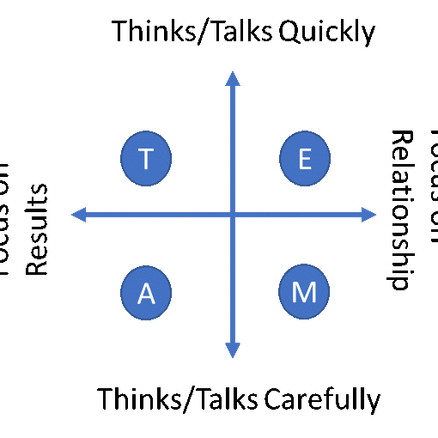First, I want to acknowledge that things are not “normal”. I see an increase in stress behaviors from everyone right now, whether because of job uncertainty, health uncertainty, financial market uncertainty or anything else – uncertainty often breeds stress behaviors. Each of us will experience this in different ways and to differing degrees based on our own experience and circumstances.
My intention here is to offer you a guide to practical steps you can take to recognize and adapt to different needs of your coworkers as it will require more intention and practice to treat people as they want to be treated right now. I’ve randomly assigned letters to allow for easier reference in the article. None of these categories is better than the other, all have strengths and challenges and all can contribute to a great team.
To identify the type of coworkers you have, I find that thinking about a quick grid can be of use.

Determine if your co-worker seems to have more of a focus on results or relationship. Where might they fall on that horizontal line? Then think about the pace at which they engage, do they think and speak quickly when a new topic comes up, or are they more measured, preferring to think things through before offering an opinion or option?
Workers that fall in category T – Results Focus and Quick to Think/Talk will most likely sound authoritative when they speak, and they will tend to be direct and candid.
For category E – Relationship Focus and Quick to Think/Talk these workers will likely sound enthusiastic when they speak, will “think out loud” a lot and will be open and engaging with others.
Workers in category A – Results Focus and Carefully with Thoughts and Words will likely speak with precision and logic and may not be expressive.
Workers in category M – Relationship Focus and Careful with Thoughts and Words will likely speak warmly and be supportive and approachable.
In addition to identifying your co-workers with the grid, it is helpful to also identify where you think you fall as well. Those that fall in the same quadrant as you will be people you have the easiest time communicating with. Those that fall in a quadrant diagonal from your usual style will be the hardest for you to communicate with typically.
Category T – Results Focus – Quick Thinking
Preferences
So, what are the category T group looking for in communication? They prefer high level summaries to in depth detail but may ask a more detailed questions where they believe it will help them come to decision. They will tend to prefer bullet points to paragraphs. They like options to consider when asked to make a decision.
Stress Behaviors
Category T stress behavior can sound overly direct and sometimes harsh in messages. They may seem abrupt, disengaging from conversation when they have the answer they need, or they may interrupt others in an effort to gather the information they are looking for or to be sure their opinions are heard and considered when deciding on a course of action.
How to work with them
What you can do to work with category T – provide options and summaries with a chance for your coworker to weigh in with ideas and to be able to make decisions. If you tend to be more careful in communication, you will want to speed up your communications with category T co-workers to get the best from them. Bring attention back to the result you are looking to share with this co-worker. Virtual tip – quick chats with clear focus on either phone or chat program
Category E – Relationship Focus – Quick Thinking
Preferences
Category E workers are looking for some fun and engagement in the work that they do and in relationships with co-workers. They enjoy being able to express views at a broad level and to brainstorm and discuss ideas. They like to know who else is involved in the project or activity.
Stress Behaviors
Under stress, category E workers may tend to be disorganized in their thinking and may overshare on ideas or information. They may allow their enthusiasm to get overwhelming for people around them. They may also interrupt because they are looking to share a thought or idea.
How to work with them
To work with your category E co-worker, provide them broad facts and talk about who will be involved or impacted by the work they are doing. Allow them time to brainstorm and discuss ideas. If it is possible to share graphics or visuals that would be great. Share your views with them openly as well and allow them to know something about you. Virtual tip – take time for some video calls and virtual happy hours.
Category A – Results Focus – Careful Thinking
Preferences
Category A workers are typically precise and logical, they enjoy researching and collecting details and facts. They are not quick to speak up, because they are reviewing their input for precision and usefulness to the conversation. Often by the time they convince themselves what they have to say is worthwhile, the faster paced team members around them have moved off the topic and lose out on this workers input.
Stress Behavior
Under stress category A employees may become even more reserved and cautious about speaking up. They may withdraw from interaction and appear too serious or modest. This withdrawal can be mis-interpreted as lack of caring or commitment to a project or to other co-workers, but may just be a need to feel more control of current circumstances.
How to work with them
Getting the best out of your category A co-worker means giving them facts and data to review. Providing agendas ahead of meetings makes these workers feel more comfortable, as they know what topics are likely to be discuss and can have thoughts ready ahead of the meeting. Helping them understand when and why the team needs to come to decision on something can also help these co-workers. Allowing them some quiet time can also be comforting. Virtual tip – Send articles for them to read or resources they can explore.
Category M – Relationship Focus – Careful Thinking
Preferences
Category M workers will be good at showing empathy and warmth and will value that when seen from others. They appreciate true connections with people and like to feel safe and valued by other team members. They enjoy helping others and are often looking for ways to contribute. They appreciate feeling secure and safe and may be among the most unsettled during uncertain times, but also doing the most outreach to family and friends and helping others stay connected.
Stress Behavior
Under stress, you may see your category M coworkers being too diplomatic, trying to please everyone. They may compromise too much on their ideas in trying to keep things harmonious and avoid conflict. This may look like over-committing to activities and then internalizing pressure to deliver to everyone. It may look like not asking for what they truly need for fear that it would be an imposition to others.
How to work with them
For category M co-workers, providing an environment that allows them to feel safe and understood is important. Other styles may need to slow down a bit and soften the tone when working with category M co-workers. Providing specific instructions to follow can be a way to provide security even in uncertain times and those instructions will be appreciated by these workers. Reminding team members of what is not changing and what remains stable during times of uncertainty can also be helpful. Spend a bit of time to connect on a personal basis before jumping to the result you need and you will help these workers feel better and more appreciated. Virtual tip – video calls and one on one communications with time for connection.
TEAM Communication
Now that you have this guideline, my hope is that you will refer to it when you begin communications with others on your team and start to recognize where and how you might flex your style to match a co-worker a bit more. You don’t have to be perfect at this. You don’t have to do it in every communication. If you are really under stress – you can even ask others to match a style that will work better for you in the moment. While we are physically distancing, I think it is important to be socially connected. Showing your willingness to match a co-workers style is a way to do care for coworkers that just might lead to more successful communications and team work.
If you are interested in learning more about this, I’m happy to help.
Be safe!


Recent Comments